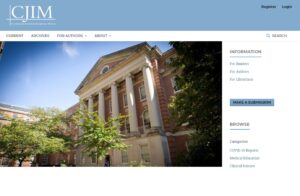Three years ago a small group of UNC School of Medicine students banded together to create the Carolina Journal of Interdisciplinary Medicine. With their first issue under their belts, the endeavor has grown to include a board of faculty advisors and more than 100 additional students. And they’re not done yet.

CHAPEL HILL, NC – Remarkable. That’s the word used most often to describe the group of students at the helm of the Carolina Journal of Interdisciplinary Medicine (CJIM), a student-run, faculty-advised, online publication based out of the University of North Carolina at Chapel Hill. The first issue came out in August, making it one of a handful of student-run medical journals across the country, and even more unique in that it aims to publish research from students in a wide variety of health science professional programs.
“I believe we have one of the best health science campuses in the country,” said William Bennett, a fourth-year medical student and co-editor-in-chief of CJIM. “I saw creating this journal as an opportunity to connect students from the various programs of our robust health science campus.”
Bennett came up with the idea at the beginning of his medical education scholarly concentration program, in which students are tasked with completing a project over their four years of medical school that either evaluates curriculum or creates a new piece of curriculum. After getting several classmates on board with the idea, they pitched it to their professors.
“I thought it was a very innovative and entrepreneurial idea,” said Kurt Gilliland, PhD, associate professor in the UNC Department of Cell Biology and Physiology and associate dean for curriculum. “I didn’t see any reason why they couldn’t do it. So they got started creating a platform for the journal.”
Bennett and his co-founders, Demitra Canoutas, Trevor Parton and Bryan Dobbs, had a range of experience with publishing, and used the knowledge they had to start checking off one journal must-have at a time – registering for Crossref so their published articles would be searchable, purchasing rights to a website platform from the Public Knowledge Project Open Journals System (which they initially funded themselves), researching and creating policies they would need to enforce, and deciding on a double-blind strategy for their peer-review process.
Then, to help with their next steps, they assembled a faculty advisory board. The board members include Gilliland and his co-director of the medical education scholarly concentration program, Gary Beck Dallaghan, PhD, director of Educational Scholarship in the Office of Medical Education; Evan Dellon, MD, MPH, professor in the UNC Department of Medicine and director of the Office of Medical Student Research; Stephen Tilley, MD, a UNC SOM alumnus and associate professor in the UNC Department of Medicine; and Maria E. Diaz-Gonzalez de Ferris, MD, MPH, PhD, professor in the UNC Department of Pediatrics and associate director of the Office of Medical Student Research. Together they guided CJIM’s co-founders, giving them the knowledge and direction they’d need for their endeavor.
“I’ve been a guest editor of several issues of scientific journals, a reviewer of scientific journals, and published scientific papers,” said Ferris. “I’ve also been a faculty advisor in academia since 1988, and I feel fortunate to see this group of exceptional students come up with such a creative idea. I’m lucky to be part of such a team.”
But there were some unexpected challenges along the way, mostly in the form of technological logistics.
“Technology was a bigger challenge than we thought it would be,” said Parton, a fourth-year medical student and co-editor-in-chief of CJIM. “We had to learn a lot more about web development and the software we use for copy editing and final production. Typesetting and formatting became a large barrier in the publishing process too.”

But the group found a way forward by bringing in Taruni Santanam, a second-year medical student, to serve as chief of design, and Seth Alexander, a fourth-year medical student, to serve as chief development officer. The pair spearheaded efforts to design article layouts, evaluate typesetting services, and acquire additional financing needed to fund a number of unforeseen costs in CJIM’s inaugural production cycle.
“I truly do not believe we would have been able to produce Volume 1 without Taruni and Seth,” Bennett said. “Their work and impact cannot be overstated.”
Yet another hurdle would be finding students to perform peer review. Initially the co-founders held an event at a student activities fair to generate interest, which yielded some responses. An invite for an interest meeting sent out via email list serves really got the ball rolling. Now, they have over 100 SOM students involved in their peer-review process, and hope to engage students from other health science schools at UNC.
The first issue of CJIM features submissions from UNC SOM students on a range of topics, giving these students a chance to not only have research published, but gain a deeper knowledge about the full peer-review process.
“The peer-review process was incredible,” Bennett said. “All of our reviewers submitted great reports on time. The editors did a great job in compiling them and sending them back to the authors. And we really tried to work with all the authors to help them sort through their research and present it in a fair and accurate way.”
CJIM’s co-founders want the journal to be a place for student research that wouldn’t otherwise be published by larger outlets. It’s a place for small studies, for null results, and for findings that may not be that novel but still indicative of strong research skills. It’s a home for interesting abstracts that normally would have ended up only in a class paper or on a poster board. And it’s for more than just UNC students. It’s open to graduate health science students across the U.S. and Canada. With a foundation for the journal in place, the co-founders’ next challenge is keeping it going.
“Now they need to sustain their efforts,” Gilliland said. “They need to make sure those who follow them at UNC, and maybe other medical schools, can keep this alive and maintain it. We have volume 1. Hopefully there will be volumes 10 and 50 one day.”
“We hope that this will become part of the graduate health science education process for many students in the years to come,” said Canoutas, a fourth-year medical student and a managing editor of CJIM. “Our goal is that this journal will, in addition to providing students a place to publish their work, provide experience with the publication process both as authors and as reviewers, editors, or in leadership positions.”
The co-founders are laying the groundwork for other students to take over after they graduate. And they will of course be keeping an eye on their creation from wherever their training and careers take them.
“My dream is for CJIM to live on as an institution perpetuated by future classes of students from all of the health sciences,” said Dobbs, a fourth-year medical student who is also pursuing a master’s of public health, and a CJIM managing editor. “I hope to be able to go to our website in 10 years and see people from medicine, dental, pharmacy, public health, and more working with the journal and publishing their work.”
If you’d like to submit research for publication, you can make a submission here. If you are interested in becoming a peer reviewer or supporting the journal in another way, contact William Bennett or Trevor Parton.